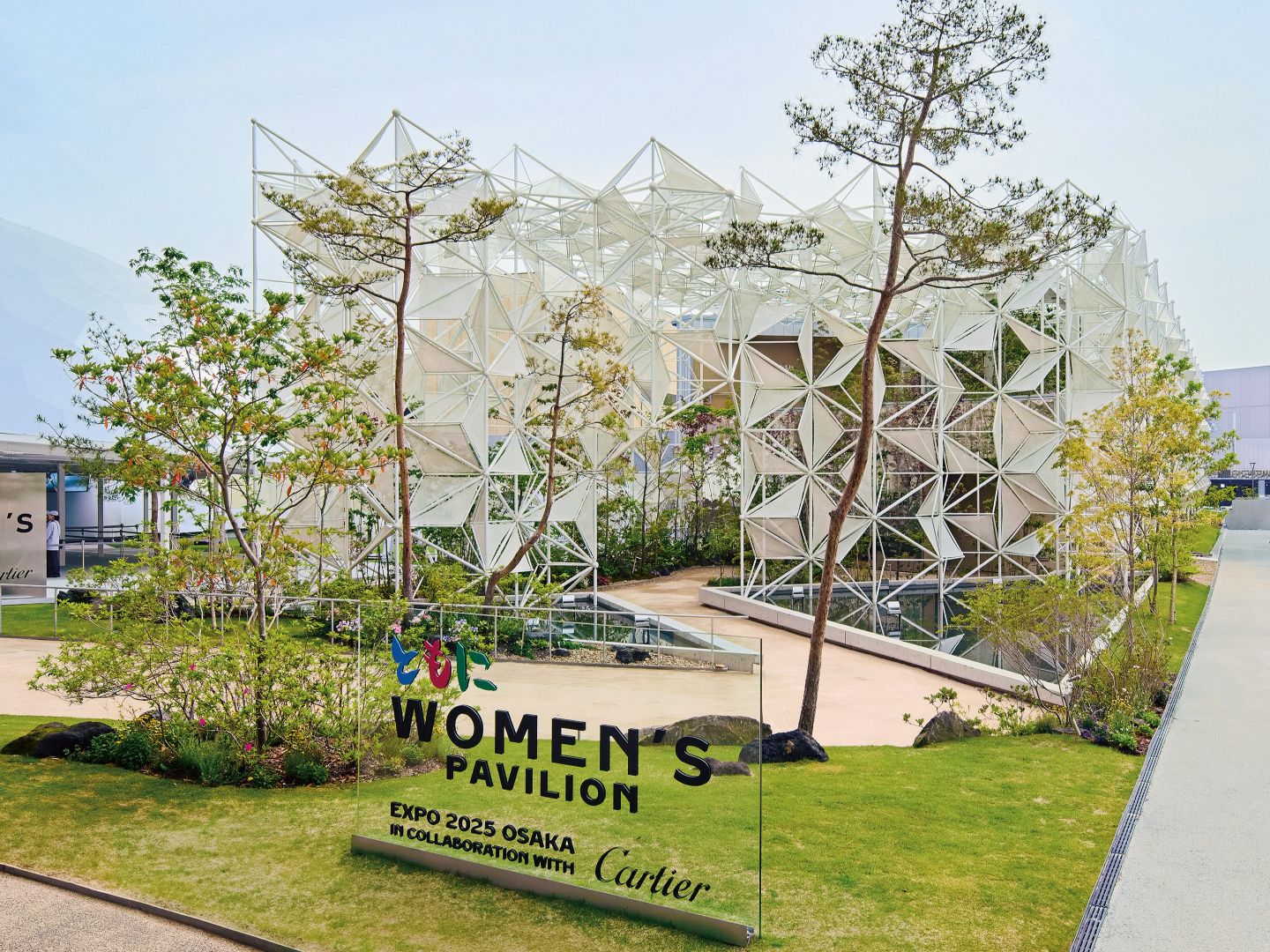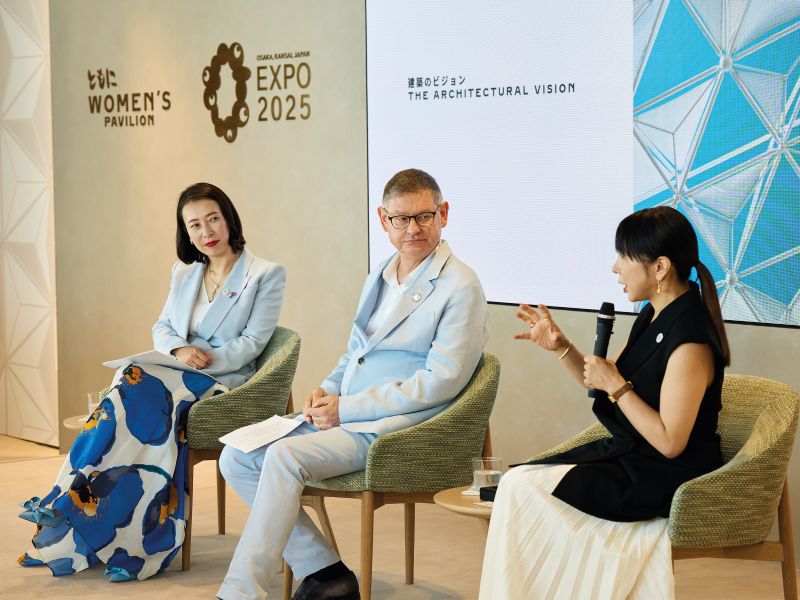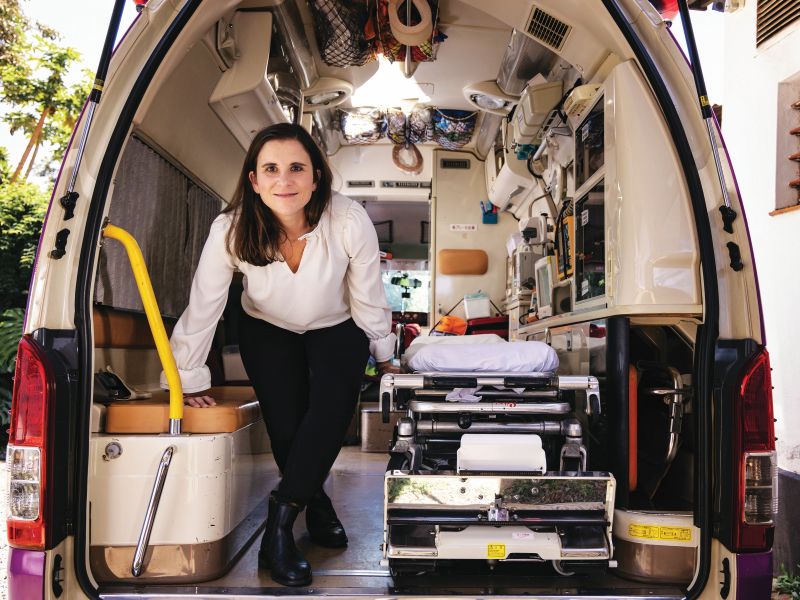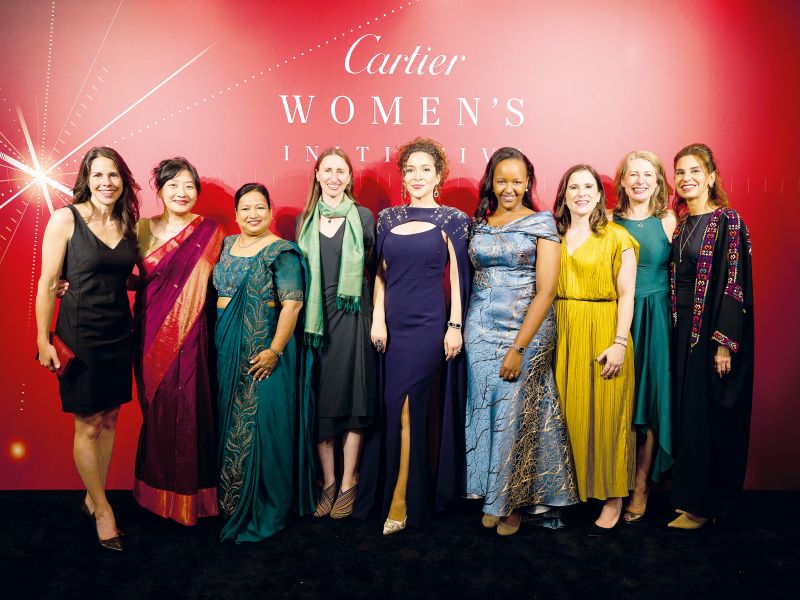
Guided by the belief that when women thrive, humanity thrives, Cartier has long championed gender equality (All photos: Cartier)
Culture today is being shaped less on the podium and more from the margins. In her breakout 1988 novel Kitchen, Yoshimoto Banana provides a vignette where everyday occurrences — the clatter of pans, the hum of a refrigerator — become stages for personal emancipation. Grief is not merely soothed by cooking but through intimate encounters that bind one’s life to another, such as sharing a meal with a transgender maternal figure who offers shelter, warmth and a new form of family. This reframing of the domestic as a site of feminine power, one that honours emotional labour and embraces fluid identities, speaks directly to the manifesto of the Cartier Women’s Pavilion at Expo 2025 Osaka, Japan: “When women thrive, humanity thrives.”
Yoshimoto is one of three central figures anchoring the narrative of the pavilion, together with Sudanese-American poet and activist Emtithal Mahmoud, and Mexican-Chilean climate advocate Xiye Bastida. Distinct yet intertwined, their endeavours unfold within a space conceived by Japanese architect Yuko Nagayama, who reused elements from her earlier design for the Japan Pavilion at Expo 2020 Dubai. The façade, made of steel rods connected by ball joints, draws on the precision of traditional kumiko woodworking, a technique that assembles wooden slats into intricate patterns without nails. In Osaka, as in Dubai, the structure’s geometric construct references the asanoha, a stylised hemp-leaf motif long associated with vitality and growth, commonly seen on garments and objects to encourage strength in children.
Beneath a canopy of triangulated lattice that filters the morning sun and wind, visitors begin their tour on a route lined with a natural scattering of moss, stones and plants sourced from the nearby mountains, grounding the experience in the local landscape of Kansai. Gleaming panels frame the surrounding greenery, leading into a narrow passage beside an earthen wall that evokes engawa, the open-air corridor typical of old Japanese homes. This yields a seamless transition from the vibrant external to a more contemplative interior.
upstairs.jpg

Nagayama, one of the country’s few prominent female architects, remarks that while the materials replicate those used for Dubai, this iteration takes on a different character. “It was inspired by the Kyoto machiya townhouse,” she says. “I like blurred boundaries, fusing the outdoors and indoors to create an organic atmosphere, so people can feel their hearts gradually opening up.”
The inner sanctum immediately softens into curves, ovals and circles. Aided by audio headphones and visual haiku, visitors are prompted to speak their name aloud while facing their reflection in a mirror, a ritual that personalises their journey from the outset. Doing so, they offer a part of themselves to the space before stepping into the stories of others, however briefly inhabiting their lives. This sensibility was dreamt up by British artist Es Devlin, who envisioned the pavilion not as a repository of statistics but a refuge that fosters empathy. While world expos have customarily served as arenas for nations to showcase their innovation and heritage, Devlin’s direction breaks with convention. “To say I’m not representing a country but all women — that’s a pretty evolved approach,” she once noted.
The trio of trailblazers is formally introduced in a dimly lit area via a film directed by Naomi Kawase. One by one, their blurred silhouettes emerge in soft monochrome before coming into sharp focus, as they walk towards the viewer and speak with intimacy. Emtithal, who promotes the transformative power of education in conflict zones and advocates for refugees, recalls moving six times in Darfur before the age of eight, a childhood marred by uncertainty. Bastida highlights how “water is life” in the mountains of Mexico. Yoshimoto explains she chose the pen name “Banana” because it is genderless and conveys gentleness.
womens_pavilion_your_name_victor_picon_ccartier_cmjn.jpg
At the end of the presentation, the women join their hands in a prayer-like gesture before slowly opening them outward, mimicking the motion of the wall as three oval apertures part like petals. Through these egg-shaped thresholds, visitors are invited to choose a path, each leading deeper into the background and perspective of one protagonist.
“Women should be on women’s side. And let’s overcome all the difficulties that come with change as happily as possible, humming along and with the carefree nature of women. We don’t have to belong to anything anymore,” the novelist urges in a separate video.
All three pathways meet at Ma, a Japanese concept that connotes pause or interval, the stillness between things.The atmosphere shifts in this room, where light streams through an opening overhead and falls on a dark, water-filled table scattered with smooth black pebbles. Each stone carries a trace of someone who has come before, and with each new visitor, the collection grows. A quiet register of presence and passage, it is a reminder that every individual story contributes to a larger, collective memory.
womens_pavilion_three_women_victor_picon_ccartier_cmjn_2.jpg
Then come the hard-hitting facts. In a separate section known as the Puzzle Box, named after the age-old Japanese chest of tricks, the installation layers global data to reveal the sobering reality of gender equality today. Studies by UN Women and the Gender Snapshot 2024 show that while progress has been made, entrenched disparities persist. Left unaddressed, climate change is projected to push as many as 158 million more women and girls into extreme poverty by 2050. This visual and statistical reckoning finds further expression in the Wa room, located on the second floor anchored by a rooftop garden. Envisaged as a communal agora, it is set to host meaningful conversations on renewal and reform.
The inaugural Wa dialogues kicked off with a compelling call to action. In one of the panels moderated by writer-broadcaster Sandi Toksvig, speakers including Cyrille Vigneron (chairman of Cartier culture and philanthropy), Kirsi Madi (deputy executive director for resource management, sustainability and partnerships at UN Women) and Dr Anino Emuwa (managing director of Avandis Consulting and founder of 100 Women @ Davos) explored how institutional, corporate and grassroots alliances can dismantle systemic barriers and advance Sustainable Development Goal (SDG) 5: gender equality.
In another conversation, human rights lawyer Amal Clooney — known for leading legal victories for ISIS survivors and expanding access to free legal aid in more than 40 countries through the Clooney Foundation for Justice, which she co-founded with her actor-husband George — highlights the ongoing threats faced by women and girls, from child marriage to sexual violence and genocide. In such contexts, altruism and humanitarianism play a vital role, she argues. “We need philanthropy, particularly from the corporate sector, to sustain these commitments.”
must_put_1.jpg

Amid the international scale of her work, Amal brings the issue closer to home, sharing how disparity reaches even the most private corners of her life. “I’m lucky enough to be the mother of twins, a boy and a girl, and they’re about to turn eight,” she says. “They would be shocked to learn that many young girls out there, no matter their talent or dreams, are denied the same opportunities and freedoms afforded to their brothers.”
Running until Oct 13, the Women’s Pavilion is one of more than 160 national and thematic spaces at Expo 2025 set on Yumeshima, a man-made island in Osaka Bay. But its impact is intended to last well beyond the six-month exhibition period: Nagayama’s striking façade will be repurposed as the main stage for the Green Expo in Yokohama in 2027. As the world observes the 30th anniversary of the Beijing Declaration and Platform for Action, this pavilion — centred around the theme tomoni (Japanese for together) — stands as both a rallying point and clarion call, affirming that justice for women and girls is inseparable from wider environmental and social causes.
Ripple effect
As community ties fray at the seams, what could be more necessary than choosing to mend with intention? The message of seeding a future in which gender no longer determines worth, safety and possibility was elevated to a larger stage during the pavilion’s official opening ceremony at the Expo Hall, hosted by award-winning actress Anna Sawai of Shōgun fame. Held in a drum-shaped auditorium modelled on cymatics (the science of visualising sound and vibration), the venue responded like a living instrument. Acoustics became shimmering patterns on a screen, translating speech and music into waves of light and movement. More than a technical spectacle, this sensory interplay was a symbolic manifestation of amplification — one that June Miyachi, president and CEO of Cartier Japan, captured in her welcome address before 1,600 guests, which included Her Imperial Highness Princess Takamado, Expo City Dubai Authority of United Arab Emirates CEO Reem Al Hashimy and former New Zealand prime minister Jacinda Ardern: “Lasting equality is within our reach when we build it together”.
womens_pavilion_opening_ceremony_dorotheee_murail_cartier_cmjn.jpg

Art became the thread that stitched emotion to ethos. Poet and UNHCR goodwill ambassador JJ Bola, whose revelatory relationship with identity and racism shape much of his repertoire, read his original work Something Beautiful, cajoling the audience to dream, remember and, ultimately, act. The event reached its crescendo in a transcendent finale that gathered wadaiko drummers, folk singer Anna Sato, youth soloists and both Japanese and international choirs. Their voices converged in The Flower of the Human Heart, inspired by Heian-era poetry and the vivid palette of Japanese spring. Drawing on the words of classical poet Izumi Shikibu, the composition gave form to a shared longing — for a planet remade through care. Hush settled over the hall, broken only by the faint rustle of people dabbing their eyes.
Amid the emotional swell, Ardern offered a counterpoint to poetry with policy. “The women before me shattered a glass ceiling, and while there were still plenty of shards raining down by the time I had the chance to follow in their footsteps, I could at least see the path ahead had already been travelled. Women still hold only roughly a quarter of parliamentary seats globally. They say you can’t be what you can’t see. But you also cannot change what isn’t within your reach.”
womens_pavilion_opening_ceremony_sina_engin_ccartier_cmjn_-_9.jpg

With hearts full and stirred, the rousing ceremony eased into a relaxed communion at the Osaka Geihinkan. Nestled in the lush grounds of Nishinomaru Garden — home to 600 cherry trees in the shadow of Osaka Castle — the historical landmark previously hosted the 1995 Apec summit. The celebration dinner began with a rare Noh performance of Wisteria, reinterpreted by the legendary Kongo family, with a female flautist bringing a note of quiet disruption to a traditionally male art form. Poet Emtithal followed with a piece steeped in themes of justice and resilience, as guests enjoyed a refined dinner by chef Kei Kobayashi, the first Japanese chef to earn three Michelin stars in France.
Action in motion
In East Africa, help arrives too late, or not at all. A single call can mean the difference between holding a newborn and mourning a mother. Flare, dubbed the “Uber for ambulances”, was established to close that devastating gap. Launched in 2017 by Caitlin Dolkart, the tech start-up operates a dedicated emergency dispatch centre that connects people 24/7 to a fleet of over 800 ambulances and more than 70 aircraft through its Rescue.co network — a lifeline in a region where no such infrastructure reliably existed.
“Why was it so difficult to find help when you needed it? We became obsessed with this question,” says Dolkart, a 2019 fellow of the Cartier Women’s Initiative (CWI) — a global entrepreneurship programme that has supported women-led businesses driving social and environmental change since 2006. “When we checked whether it was a supply issue, we were shocked. Nairobi has more ambulances per capita than London, but most weren’t mobilised or properly managed. Through our ability to access real-time data, we aim to change that.”
cwi_caitlin.jpg

Since joining CWI, that ambition has only gained momentum. With the visibility that came through the fellowship, Flare has expanded across the region, slashing average response time by an astonishing 97%, from three hours to just 16 minutes. And Dolkart’s next-generation 911 is not the only breakthrough to benefit from the initiative. Since its founding, it has supported 330 fellows from 66 countries, providing over US$12 million in funding, executive education at INSEAD and nurturing a growing community of more than 500 change makers. This year, at the Sakai Performance Arts Centre, CWI honoured nine former fellows whose ventures have significantly scaled their missions over time.
These Impact Awardees were selected across three categories — Preserving the Planet, Improving Lives and Creating Opportunities — each aligned with the SDGs and addressing the full spectrum of the 17 global targets.
Sustainability encompasses both instinct and ingenuity, as demonstrated by the recipients in the first category. In Ireland, Tracy O’Rourke’s Vivid Edge offers energy efficiency as a service, helping companies reduce energy waste without upfront costs. Her model has saved 36,457 tons of carbon emissions and energy enough to power nearly 28,500 homes. Across the UK, Kresse Wesling has diverted more than 315 tons of fire hoses and leather offcuts from landfills, converting them into luxury goods while donating over US$500,000 to firefighter-related charities. Meanwhile, Kristin Kagetsu’s Saathi, operating in India, produces biodegradable sanitary pads made from banana fibre, a solution that has reached more than 114,000 users, prevented 92 tonnes of plastic waste and created jobs for nearly 500 women from marginalised groups.
Joining Dolkart in Improving Lives is Namita Banka, who is tackling India’s sanitation crisis through Banka Bioloo — an enterprise that has installed 3,000 biotoilets for Indian Railways — serving 10 million daily passengers, along with an additional 30,000 units in rural areas. Today, it stands as the country’s first publicly listed sanitation company, employing over 1,000 staff. In Rwanda, Yvette Ishimwe is changing what access to clean water looks like. Her IRIBA Water Group uses solar-powered ATMs to distribute safe drinking water in underserved regions, reaching more than half a million people and lowering chances of waterborne diseases in schools by 37%.
cwi_must_put_under_action_to_motion.jpg

Creating Opportunities is about expanding resources for those often overlooked. Rama Kayyali’s digital Arabic literacy platform, Little Thinking Minds, has improved reading outcomes by 25% and now reaches more than 400,000 learners across the Middle East, including refugee children. Mariam Torosyan from Armenia has developed the Safe YOU app into a cross-border support system for survivors to report violence, reaching 40,000 users across five countries. Jackie Stenson’s Essmart distributes products like solar lanterns and clean cookstoves to rural India, impacting 1.4 million lives, cutting over 100 million kg of carbon dioxide emissions and assisting 5,000 shopkeepers grow their businesses.
Beyond recognition, all awardees received a US$100,000 grant and year-long fellowship tailored to accelerate their growth, with support ranging from media exposure to strategic planning, leadership training and peer learning.
This gathering of voices in Osaka, from the Women’s Pavilion to CWI, not only highlights the ideas that have taken root, but also the influence still being shaped. In that unfolding, we are reminded that real change is rarely solitary — it begins with one determined person, and gains strength through the conviction and contributions of many.
Applications for the 2026 Cartier Women’s Initiative are open until June 24, with the global awards ceremony to take place in Thailand. Submit here.
This article first appeared on June 2, 2025 in The Edge Malaysia.


